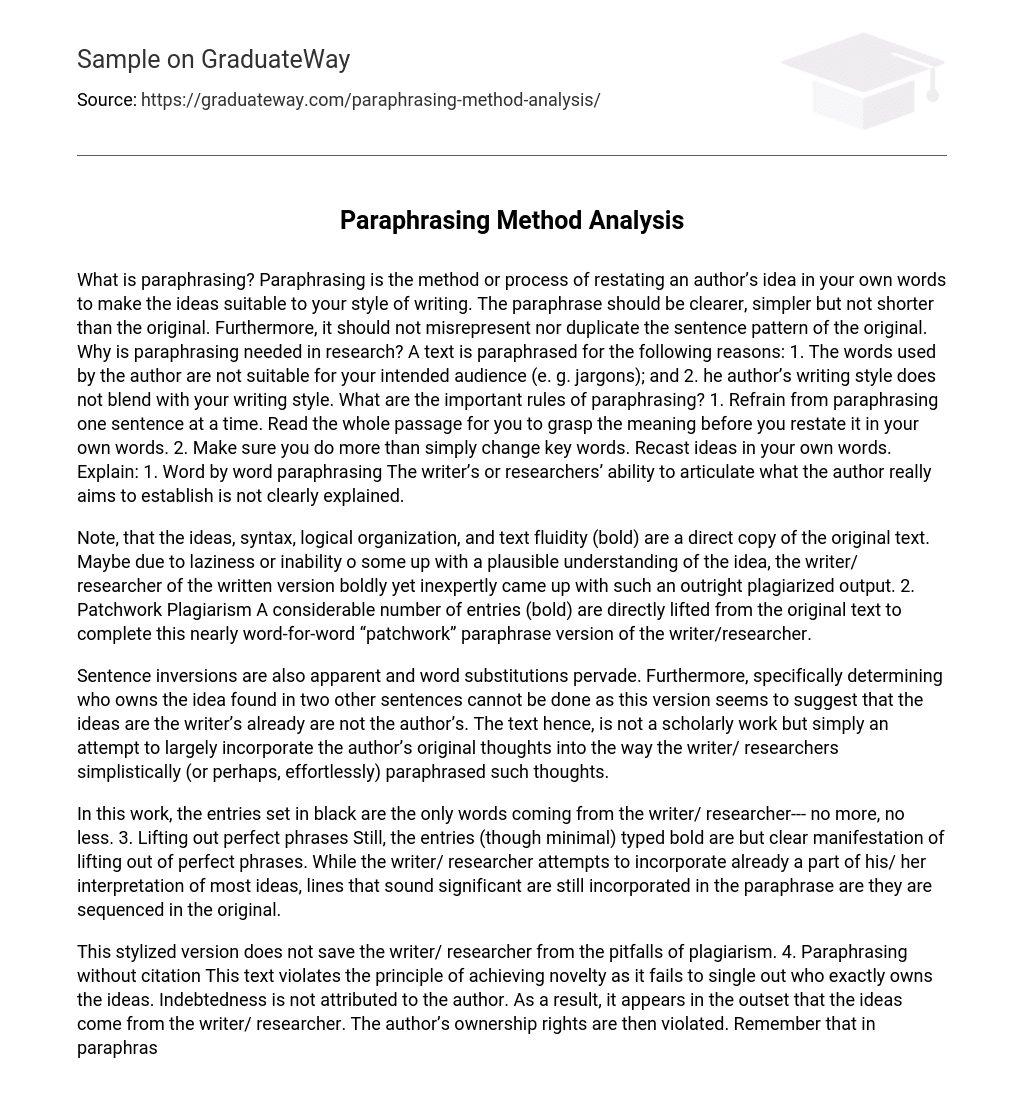What is paraphrasing? Paraphrasing is the method or process of restating an author’s idea in your own words to make the ideas suitable to your style of writing. The paraphrase should be clearer, simpler but not shorter than the original. Furthermore, it should not misrepresent nor duplicate the sentence pattern of the original. Why is paraphrasing needed in research? A text is paraphrased for the following reasons: 1. The words used by the author are not suitable for your intended audience (e. g. jargons); and 2. he author’s writing style does not blend with your writing style. What are the important rules of paraphrasing? 1. Refrain from paraphrasing one sentence at a time. Read the whole passage for you to grasp the meaning before you restate it in your own words. 2. Make sure you do more than simply change key words. Recast ideas in your own words. Explain: 1. Word by word paraphrasing The writer’s or researchers’ ability to articulate what the author really aims to establish is not clearly explained.
Note, that the ideas, syntax, logical organization, and text fluidity (bold) are a direct copy of the original text. Maybe due to laziness or inability o some up with a plausible understanding of the idea, the writer/ researcher of the written version boldly yet inexpertly came up with such an outright plagiarized output. 2. Patchwork Plagiarism A considerable number of entries (bold) are directly lifted from the original text to complete this nearly word-for-word “patchwork” paraphrase version of the writer/researcher.
Sentence inversions are also apparent and word substitutions pervade. Furthermore, specifically determining who owns the idea found in two other sentences cannot be done as this version seems to suggest that the ideas are the writer’s already are not the author’s. The text hence, is not a scholarly work but simply an attempt to largely incorporate the author’s original thoughts into the way the writer/ researchers simplistically (or perhaps, effortlessly) paraphrased such thoughts.
In this work, the entries set in black are the only words coming from the writer/ researcher— no more, no less. 3. Lifting out perfect phrases Still, the entries (though minimal) typed bold are but clear manifestation of lifting out of perfect phrases. While the writer/ researcher attempts to incorporate already a part of his/ her interpretation of most ideas, lines that sound significant are still incorporated in the paraphrase are they are sequenced in the original.
This stylized version does not save the writer/ researcher from the pitfalls of plagiarism. 4. Paraphrasing without citation This text violates the principle of achieving novelty as it fails to single out who exactly owns the ideas. Indebtedness is not attributed to the author. As a result, it appears in the outset that the ideas come from the writer/ researcher. The author’s ownership rights are then violated. Remember that in paraphrasing an idea, the author— being the owner of the paraphrased idea— should and must always be cited.
Your attempt (as a writer/ researcher) at paraphrasing an idea that will largely strengthen your paper is simply as expression of the way you understood that idea. In doing appropriate citation, you acknowledge you indebtedness to the owner of the idea and thus tickets you to advance scholarship professionally and academically. As have been presented, coming up with a research paper that contains a clear-cut presentation of these versions—either in or part in a whole— already constitutes what is so called plagiarism.
As a writer/ researcher, you must always subscribe to maintaining high standard of professionalism. This include, among others, being able to manifest your indebtedness whom you have cited in you research. Consider that without these authors’ insights; your paper will appear rather wanting. As well, keep in mind to always cite the authors as you try to paraphrase their insights. Simply put, coming up with a paraphrased version of the paraphrased version of the idea cited— be they at phrase, clause, sentence, or paragraph levels— requires you to acknowledge the authors.
What is an acceptable paraphrasing? All the entries are attributed to the owner of the ideas. While attribution is made explicit, the original text is also paraphrased. Note as well that even it requires documentation or citation of the author. Furthermore, through use of pronoun she, readers are made aware that these ideas are not the writer’s/ researcher’s. However, where clear-cut lifting of ideas has to be made, the writer/ researcher made use of quotation marks.





